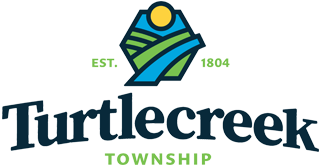About
Our History
What's in a Name?
Most folks are aware that Turtle Creek meanders through Turtlecreek Township. However, that's not how the Township got its name. According to the late Warren County historian Marion Snyder, the area is named for renowned warrior Little Turtle, Chief of the Miamis. Mr. Snyder also settled the matter of whether Turtlecreek Township is written as one word or two. Reading from an 1850 Turtlecreek Township Trustee book of minutes, Mr. Snyder noted that Turtlecreek Township is written as one word. On most maps, though, folks will still see the Township's name written as two separate words.
The Early Years: Township Organization
According to History of Warren County, Ohio, Turtlecreek Township was organized on August 15, 1804. Originally, the Township included a part of Union and all of Salem Townships north and west of the Little Miami River, making it the largest township in the country. The east, north and southern boundaries have been changed, leaving a land area of approximately 56.388 square miles (down from 70.4 due to various annexations by adjoining municipalities).
Early Settlers
The first settlement in the Township was made at Bedle's Station in 1795 (in the area around the intersection of the present-day State Route 63 and State Route 741). It is believed that in September, 1795, the first families built their cabins around Bedle's Block House. Here William Bedle, with his sons-in-law and their families, lived in much simplicity. Within two or three years, other settlers gathered around in such numbers that Bedle's Station became quite a well-known settlement.
Among the first settlers were:
- John Shaw, a member of the Seceder Church, in the fall of 1795
- Ichabod Corwin, in March of 1796, whose first cabin was built on the west side of Turtle Creek. He later built a second cabin which became known as "the house of Ephraim Hathaway or Turtle Creek,"-The first seat of justice of Warren County.
- Henry Taylor, before the close of 1796
- Samuel Manning, in 1796, who purchased land for $1 per acre
- John Osborn, Sr.,about the year 1796
- Some of the other pioneers included Daniel Banta, Jacob Trimble, William Dill, Patrick Meloy, Elder Daniel Clark, James Cowan, Daniel Cory, Francis Dunlevy, William Davis, Lewis Drake, Levi Estell, Samuel Galleher, Joseph Hatfield, Nathan Hatahway, Ichabod B. Halsey, David Reeder, Cornelius Voorhis, and Peter Yauger
The Shakers
According to the Combined Atlases of Warren County, Ohio (sponsored by the Warren County Historical Society), "Following the remarkable and peculiar revivals experienced from 1801 to 1803 came strangers representing a new sect-the Shakers. The news of the remarkable revival had reached them at New Lebanon, New York, and, as their method of worship was attended with more or less physical manifestation, not entirely unlike those witnessed in revivals, they hoped their stange doctrine would find a ready acceptance."
"March 22, 1805, three strangers in peculear garb arrived at Turtlecreek. They were Shakers-the first even seen west of the Allegheny Mountains-and had made the entire journey of over one thousand miles from New Lebanon on foot."
"The following Sunday, they were permitted to preach in Turtlecreek Church. They had been correct in believing that a revival of two years before had prepared the way for the acceptance of their doctrine. Within a month a dozen families, including the pastor of the little flock of Turtlecreek, had embraced their faith. The Shaker doctrine forbidding marriage, husbands and wives abandoned their family relations, and, giving up their property to the society which had been formed, became the Shakers. Thus was obtained a large part of a splendid tract of four thousand acres of land lying in the western portion of Turtlecreek Township, and which was kept intact for many years until two large tracts eventually were sold."
"The Union Village Society was organized May 25, 1805. Workers went out, and converts were made in all directions, who came flocking into Union Village. The Society soon came to be a strong one, numerically and financially. The Shakers were generally recognized as being scrupulously honest in all their dealings. They were benevolent in their way, and any unprotected orphan children were given a home among them."
"In 1829 the membership reached the highest mark-about five hundred. Shaker Village, as it then existed, was exceedingly quiet, though pleasant, and even wore an air of cheerfulness. And yet with all the beauty, conveniences, and even luxuries of Shaker Village, its numbers eventually diminished until scarcely more than a score of persons were there, and the time seemed not far distant when Shakerism would exist only in memory." Currently, Otterbein Home Retirement Village rests on the original Shaker property.
Today and Tomorrow
Turtlecreek Township has come a long way since the original settlement. From 1796 to 1800, historian Josiah Morrow recorded a population of approximately 150 residents. In the 1990 Decennial Census, population was established as 10,311 and is now estimated at 15,143.
Turtlecreek Township is basically a residential/agricultural community with only a few businesses or commercial establishments. Over the past few years, many new subdivisions have been built or are now in the process of being built, to accommodate the growing population.
With the added housing and population surge, Township services, such as Fire and EMS services and Road and Bridge Departments services, must also increase to serve our residents. The Road and Bridge Department currently maintains 66.526 miles of roadway, and the Fire and EMS provided emergency assistance and fire protection for all residents.
